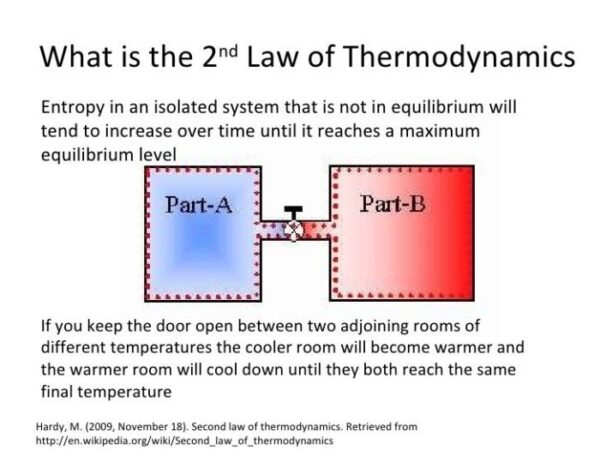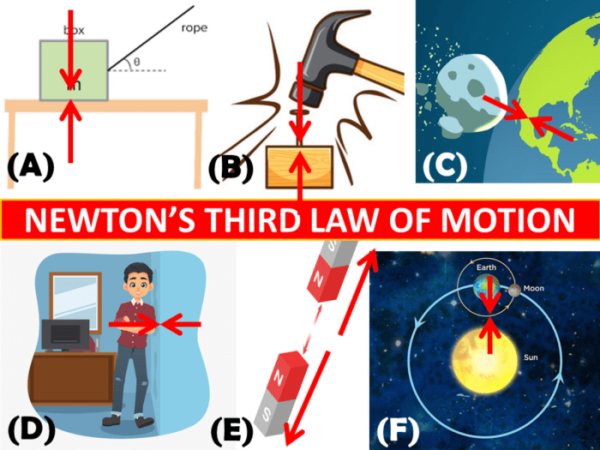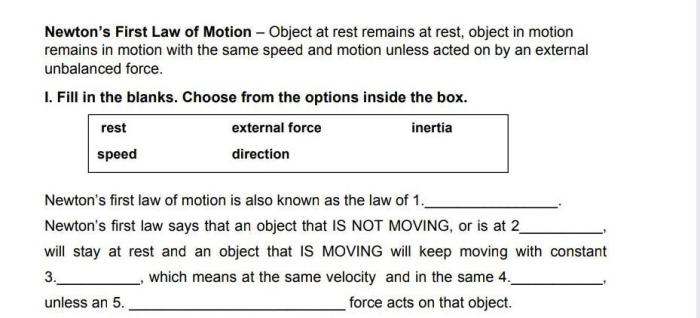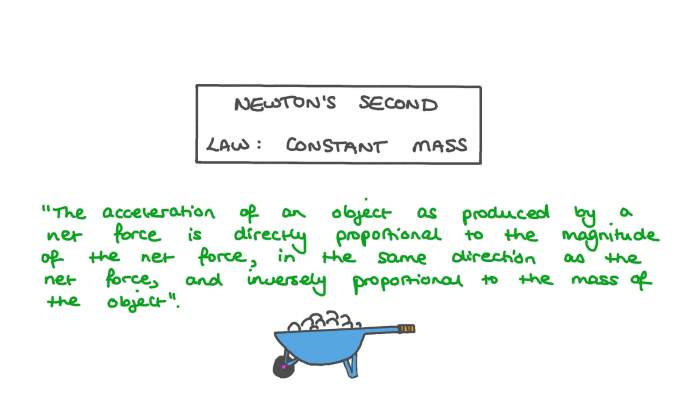
What are Newton’s laws of motion? These fundamental principles, formulated by Sir Isaac Newton in the 17th century, form the bedrock of classical mechanics and provide a framework for understanding the motion of objects in the universe. They are not merely abstract concepts but rather tangible forces that govern everything from the simple act of walking to the complex movements of planets around the sun.
Newton’s laws, with their elegant simplicity, have revolutionized our understanding of the physical world. They explain why objects at rest tend to stay at rest, why objects in motion tend to stay in motion, and how forces cause objects to accelerate. These laws are not just theoretical constructs; they are the foundation for countless technological advancements, from the design of automobiles and airplanes to the exploration of space.
Introduction to Newton’s Laws of Motion
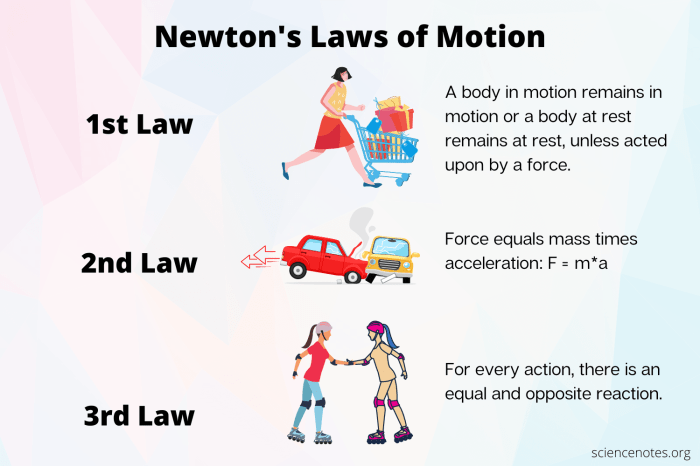
Newton’s laws of motion are fundamental principles in physics that describe the relationship between an object’s motion and the forces acting upon it. These laws, formulated by Sir Isaac Newton in the 17th century, revolutionized our understanding of the physical world and laid the foundation for classical mechanics.
Historical Context
Before Newton, the prevailing view of motion was based on the ideas of Aristotle, who believed that a force was required to keep an object moving. Newton, through his observations and experiments, challenged this notion and proposed that an object at rest would remain at rest, and an object in motion would continue in motion at a constant velocity unless acted upon by an external force. This concept, known as inertia, forms the basis of Newton’s first law of motion.
Significance of Newton’s Laws
Newton’s laws of motion are essential for understanding the behavior of objects in motion. They are widely used in various fields, including engineering, aerospace, and even everyday life. These laws allow us to predict the motion of objects, design machines, and understand the forces involved in various physical phenomena.
Applications of Newton’s Laws in Everyday Life
Newton’s laws are not just theoretical concepts; they are applicable in many aspects of our daily lives. For example, when we ride a bicycle, we use Newton’s laws to maintain balance and control the bike’s motion. When we throw a ball, we apply a force to it, causing it to accelerate and follow a trajectory governed by Newton’s laws. The braking system in cars relies on Newton’s third law of motion, which states that for every action, there is an equal and opposite reaction.
Newton’s First Law of Motion
Newton’s First Law of Motion, also known as the Law of Inertia, describes the fundamental tendency of objects to resist changes in their state of motion. It states that an object at rest will remain at rest, and an object in motion will continue in motion at a constant velocity unless acted upon by a net external force.
Inertia
Inertia is the inherent property of matter that resists changes in its state of motion. It is the tendency of an object to resist acceleration. The more massive an object is, the greater its inertia. This means that a more massive object requires a greater force to change its velocity.
Inertia in Action
Inertia affects objects both at rest and in motion.
Objects at Rest
- Imagine a book resting on a table. The book will remain at rest unless a force, such as a push or a pull, acts upon it. This is because the book has inertia, which resists any change in its state of motion.
- When you are riding in a car that suddenly stops, your body continues to move forward due to inertia. This is why you might feel like you are being thrown forward.
Objects in Motion
- A ball rolling across a smooth floor will continue to roll at a constant velocity unless acted upon by a force, such as friction or a bump. This is because the ball has inertia, which resists any change in its state of motion.
- A hockey puck sliding across the ice will continue to slide at a constant velocity unless acted upon by a force, such as friction or a hit from another player. This is because the puck has inertia, which resists any change in its state of motion.
Examples of Inertia
- When you shake a rug to remove dust, the dust particles tend to stay at rest due to inertia. As the rug moves, the dust particles fall to the floor because they are not moving with the rug.
- When a car turns sharply, passengers tend to continue moving in a straight line due to inertia. This is why you may feel like you are being pushed to the side of the car.
- A roller coaster car continues to move even when it reaches the top of a hill. This is because the car has inertia, which resists any change in its state of motion.
Newton’s Second Law of Motion
Newton’s Second Law of Motion describes the relationship between force, mass, and acceleration. It states that the acceleration of an object is directly proportional to the net force acting on it and inversely proportional to its mass. This means that a larger force will produce a larger acceleration, while a larger mass will produce a smaller acceleration for the same force.
Force Causes Acceleration
Newton’s Second Law explains how force causes acceleration. When a force acts on an object, it causes the object to change its velocity. This change in velocity is called acceleration. The direction of the acceleration is the same as the direction of the force.
The formula for Newton’s Second Law is: F = ma, where F is the net force, m is the mass, and a is the acceleration.
The relationship between force, mass, and acceleration is fundamental to understanding how objects move. For example, if you push a heavy box with a small force, it will accelerate slowly. But if you push the same box with a larger force, it will accelerate faster. Similarly, if you push a lighter box with the same force, it will accelerate faster than the heavier box.
Examples of Forces and Accelerations
The following table shows examples of forces and their corresponding accelerations:
| Force | Acceleration |
|—|—|
| Gravity | 9.8 m/s² (on Earth) |
| Friction | Varies depending on the surfaces in contact |
| Air resistance | Varies depending on the speed and shape of the object |
| Tension | Varies depending on the force applied to the rope or string |
| Normal force | Equal and opposite to the force pressing on a surface |
| Applied force | Varies depending on the force applied |
For example, the force of gravity causes objects to accelerate downwards at a rate of 9.8 m/s² on Earth. This means that an object dropped from a height will increase its speed by 9.8 meters per second every second it falls. Friction is a force that opposes motion, and it can cause an object to slow down or stop. Air resistance is a force that opposes the motion of objects through the air. Tension is a force that is transmitted through a rope, string, or cable when it is pulled tight. The normal force is a force that acts perpendicular to a surface, and it is equal and opposite to the force pressing on the surface. An applied force is any force that is applied to an object by an external agent.
Newton’s Third Law of Motion
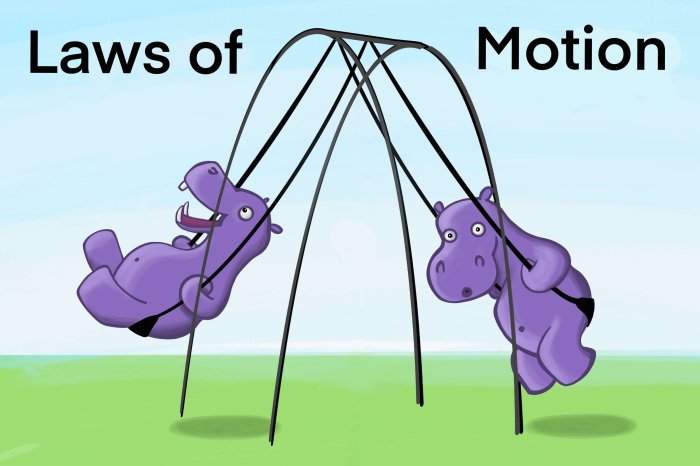
Newton’s Third Law of Motion, often referred to as the “action-reaction” law, is a fundamental principle that governs the interactions between objects. It states that for every action, there is an equal and opposite reaction. This means that when one object exerts a force on another object, the second object exerts an equal and opposite force back on the first object.
Action and Reaction Forces
This law highlights the fundamental concept that forces always occur in pairs. When an object exerts a force on another object (the action force), the second object simultaneously exerts an equal and opposite force back on the first object (the reaction force). These forces always act on different objects, and they are equal in magnitude but opposite in direction.
Real-World Examples of Newton’s Third Law
Walking
When you walk, you push your foot backward against the ground (action force). In response, the ground pushes forward on your foot with an equal and opposite force (reaction force). This forward force is what propels you forward.
Swimming
When you swim, you push water backward with your arms and legs (action force). The water pushes you forward with an equal and opposite force (reaction force). This forward force is what propels you through the water.
Rocket Launch
A rocket expels hot gases downward (action force). The gases push back on the rocket with an equal and opposite force (reaction force). This upward force is what propels the rocket into the air.
Jumping
When you jump, you push down on the ground (action force). The ground pushes back on you with an equal and opposite force (reaction force). This upward force is what launches you into the air.
Pairs of Action-Reaction Forces
The following table illustrates some common pairs of action-reaction forces:
| Action Force | Reaction Force |
|—|—|
| A book resting on a table pushes down on the table | The table pushes up on the book |
| A hammer hits a nail | The nail exerts an equal and opposite force on the hammer |
| A car accelerates forward | The road exerts an equal and opposite force backward on the car |
| A person pushes a wall | The wall pushes back on the person with an equal and opposite force |
Applications of Newton’s Laws
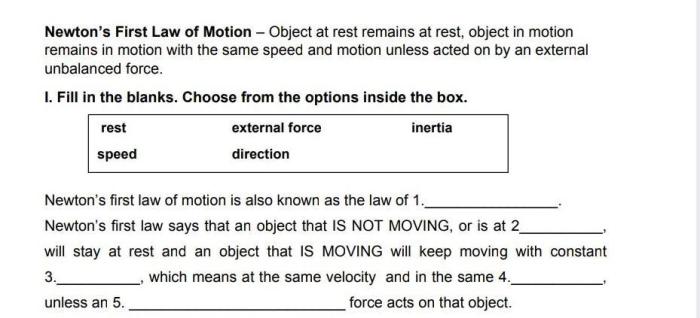
Newton’s laws of motion, fundamental principles governing the motion of objects, are not merely theoretical concepts. They are deeply intertwined with our understanding of the physical world and have profound implications for numerous fields. These laws serve as the bedrock for numerous scientific advancements and technological innovations, shaping our world in countless ways.
Engineering Applications
Newton’s laws play a pivotal role in various engineering disciplines, enabling engineers to design and analyze structures, machines, and systems.
- Structural Engineering: Engineers use Newton’s laws to calculate forces acting on buildings, bridges, and other structures. These calculations ensure the stability and safety of these structures, taking into account factors such as weight, wind loads, and seismic activity.
- Mechanical Engineering: Newton’s laws are fundamental in designing and analyzing machines, engines, and other mechanical systems. They are used to determine the forces required to move objects, calculate the efficiency of engines, and optimize the performance of mechanical systems.
- Aerospace Engineering: The principles of Newton’s laws are crucial in designing and analyzing aircraft and spacecraft. These laws are used to calculate the forces acting on these vehicles during flight, including lift, drag, and thrust, ensuring safe and efficient operation.
Physics Applications, What are newton’s laws
Newton’s laws are foundational principles in physics, providing the framework for understanding the motion of objects in various contexts.
- Classical Mechanics: Newton’s laws form the cornerstone of classical mechanics, describing the motion of macroscopic objects at everyday speeds and scales. They are used to predict the motion of planets, projectiles, and other objects in a wide range of physical scenarios.
- Astrophysics: Newton’s laws are essential in understanding the motion of celestial bodies, such as planets, stars, and galaxies. They are used to model the orbits of planets around stars, the dynamics of star clusters, and the evolution of galaxies.
- Fluid Mechanics: While Newton’s laws directly apply to rigid bodies, their principles are extended to fluid dynamics through the concept of viscosity and pressure. This allows us to analyze the motion of liquids and gases, leading to applications in areas like weather forecasting, fluid flow in pipelines, and the design of aircraft wings.
Impact on Scientific Advancements
Newton’s laws have had a profound impact on scientific advancements, serving as a catalyst for numerous discoveries and innovations.
- Universal Gravitation: Newton’s law of universal gravitation, derived from his laws of motion, explained the force of attraction between any two objects with mass. This led to a deeper understanding of the solar system and the motion of celestial bodies.
- Development of Calculus: Newton’s work on motion and calculus are intertwined. He developed calculus to describe the changing velocity and acceleration of objects, which revolutionized mathematics and its applications in physics and other sciences.
- Technological Innovations: Newton’s laws have laid the foundation for countless technological advancements, from the development of engines and machines to the design of spacecraft and sophisticated scientific instruments.
Ultimate Conclusion: What Are Newton’s Laws
From the stillness of a stationary object to the celestial dance of planets, Newton’s laws of motion provide a powerful lens through which we can understand the universe. They are a testament to the enduring power of scientific inquiry and the remarkable insights that can be gleaned from careful observation and rigorous analysis. These laws, though formulated centuries ago, continue to shape our understanding of the world around us and remain a cornerstone of modern physics.
Frequently Asked Questions
What is the significance of Newton’s laws?
Newton’s laws are significant because they provide a fundamental understanding of how objects move and interact with each other. They form the basis of classical mechanics, which is used to describe and predict the motion of objects from everyday objects to planets.
Are Newton’s laws always applicable?
While Newton’s laws are incredibly useful for describing the motion of everyday objects, they break down at very high speeds or in very strong gravitational fields. In these cases, we need to use Einstein’s theory of relativity.
How do Newton’s laws relate to everyday life?
Newton’s laws are at work in countless everyday situations. For example, when you push a shopping cart, you are applying a force to accelerate it. When you ride a bike, you are using inertia to maintain your balance. And when you throw a ball, you are using Newton’s laws to calculate its trajectory.
